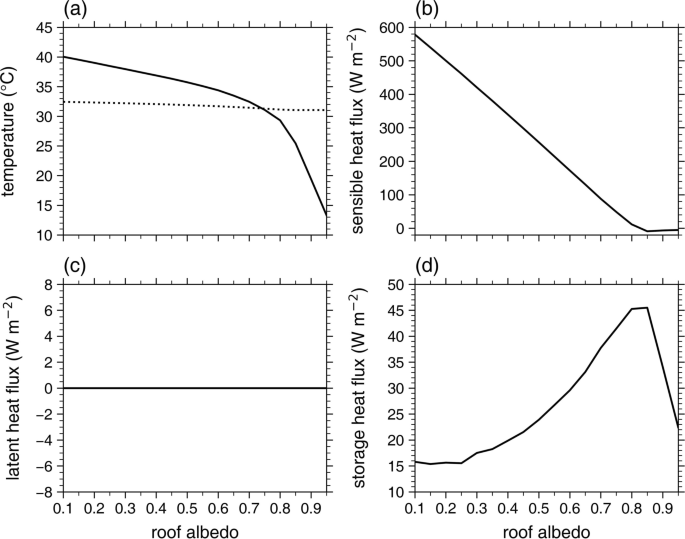Researchers have uncovered a fascinating and complex relationship between the reflectivity of roofs (known as roof albedo) and key aspects of the urban environment, including the urban heat island effect, urban air circulation, and urban air pollution levels. This groundbreaking study, conducted by scientists Kyeongjoo Park and Jong-Jin Baik, provides valuable insights into how modifying the albedo of roofs in cities can have far-reaching impacts on local climate and air quality. The findings have important implications for urban planning and the development of effective strategies to mitigate the adverse effects of urbanization. Urban heat island, air pollution, and albedo are all critical factors that influence the livability and sustainability of our cities.
Uncovering the Nonlinear Relationship Between Roof Albedo and Urban Climate
Urban areas, which now house more than 50% of the world’s population, have a significant impact on local climate due to the dense population and extensive infrastructure. One of the most well-known effects is the urban heat island (UHI), where urban areas exhibit higher near-surface air temperatures compared to their surrounding rural areas. The UHI can have adverse health effects on urban residents, especially during warm seasons, and its impact is expected to intensify with climate change and increasing heat wave occurrences.
To mitigate the UHI, researchers have explored various strategies, with the cool roof (or reflective roof) being one of the most widely adopted measures. Cool roofs are designed to have a higher albedo (reflectivity) and emissivity than conventional roofs, effectively reducing the amount of solar radiation absorbed by the roof surface and, in turn, lowering the urban temperature.
Unveiling the Nonlinear Relationship Between Roof Albedo and Urban Environments

In this groundbreaking study, researchers Kyeongjoo Park and Jong-Jin Baik from Seoul National University systematically examined how the UHI, urban breeze circulation (UBC), and urban air pollutant dispersion respond to changes in roof albedo. Using the Weather Research and Forecasting (WRF) model coupled with a sophisticated urban canopy model, the researchers conducted a series of idealized ensemble simulations with varying roof albedo values, ranging from 0.10 to 0.95.
The results revealed a fascinating and nonlinear relationship between roof albedo and these key urban environmental factors. As the roof albedo increased from 0.20 to 0.65, the daytime UHI intensity, UBC intensity, and urban planetary boundary layer height decreased by 47%, 36%, and 6%, respectively. This is consistent with the expected benefits of cool roofs in mitigating the UHI.

Fig. 2
However, the researchers made an intriguing discovery: the rates of change in the UHI intensity, UBC intensity, and urban air pollutant concentration with increasing roof albedo were not linear. For roof albedo values between 0.10 and 0.80, the rates of change generally increased as the albedo increased. But for roof albedo values of 0.80 and above, the changes in these urban environmental factors became very slight, indicating a diminishing effect of further increasing the roof albedo.
Understanding the Underlying Mechanisms
The researchers delved deeper to uncover the physical mechanisms behind this nonlinear relationship. They found that as the roof albedo increased, the daytime roof surface temperature decreased significantly, leading to changes in the roof surface energy fluxes.

Fig. 3
Specifically, for roof albedo values between 0.10 and 0.80, the increase in albedo resulted in a greater proportion of the absorbed solar radiation being stored in the roof subsurface, rather than being transferred as sensible heat to the urban atmosphere. This delayed heat storage process contributed to the enhanced mitigation of the UHI, UBC, and urban air pollution during this albedo range.
However, for roof albedo values of 0.80 and above, the roof surface temperature became notably lower than the urban near-surface air temperature, leading to a significant reduction in the upward sensible heat flux from the roof. This, in turn, weakened the impact of increasing roof albedo on the urban environmental factors.
Implications and Future Directions

Fig. 4
The findings of this study have important implications for urban planning and the development of effective strategies to mitigate the adverse effects of urbanization. By understanding the nonlinear relationship between roof albedo and key urban environmental factors, city planners and policymakers can make more informed decisions about the optimal range of roof albedo to target for their specific urban settings.
Moreover, the study highlights the need to consider the complex interactions between roof surface energy fluxes, urban circulations, and air quality when evaluating the effectiveness of cool roof strategies. Future research should explore the impact of different urban characteristics, seasons, and latitudes on these nonlinear relationships, further advancing our understanding of the intricate connections between urban form, climate, and air quality.
As our cities continue to grow and evolve, the insights provided by this groundbreaking study will be crucial in developing sustainable and livable urban environments that can better withstand the challenges of a changing climate and rising urban populations.
Author credit: This article is based on research by Kyeongjoo Park, Jong-Jin Baik.
For More Related Articles Click Here
